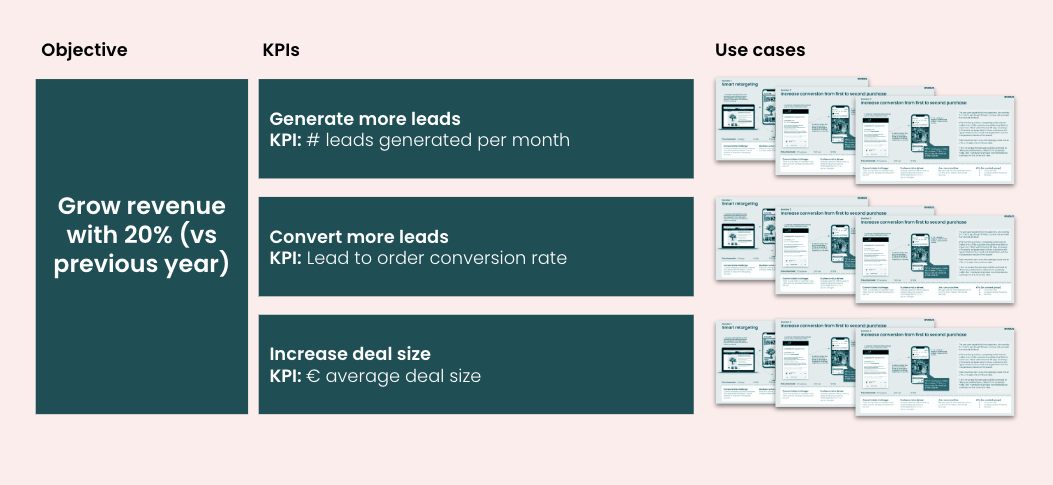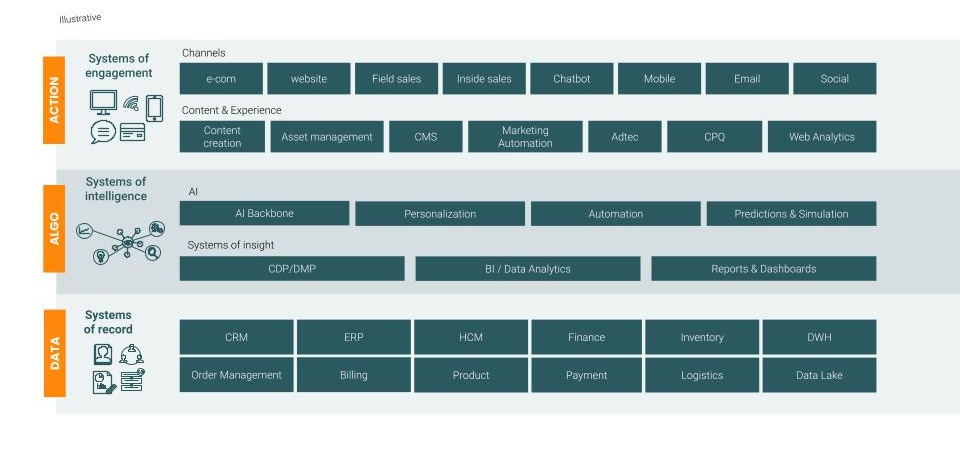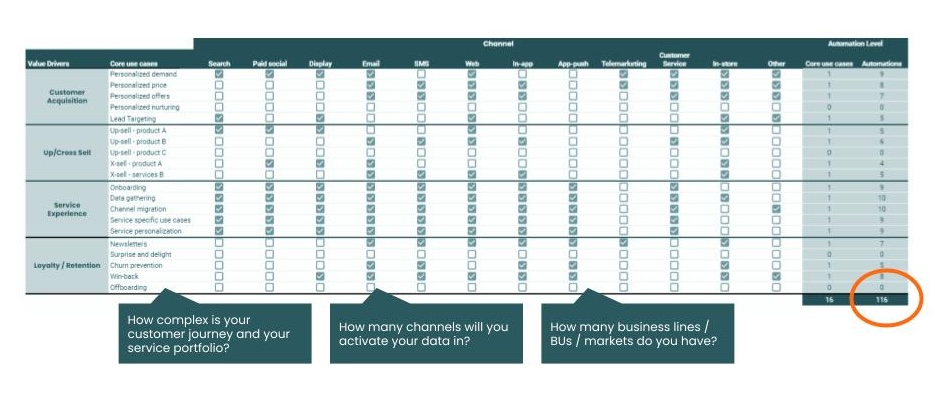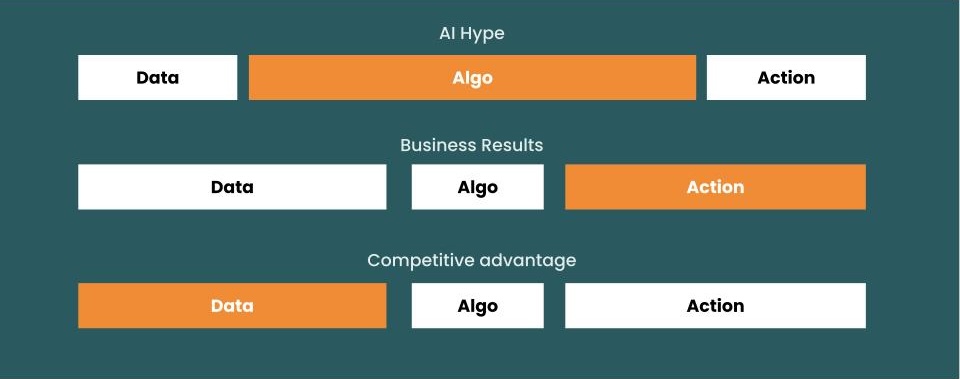If you’re in charge of marketing, sales or service in your organization you can really make a difference by increasing the effectiveness of marketing technology (MarTech). In our recent webinar “MarTech in 2024 – get more with what you have” we shared tips on how to use your existing MarTech more effectively. Here’s a breakdown of the main ideas for boosting your marketing efforts, based on our experiences from more than 1000 MarTech-related initiatives across B2C and B2B clients.
In this context “MarTech” refers to tools and platforms that help marketing and sales teams to reach, win and keep customers. Examples of these are CRM systems, Marketing Automation platforms, Customer data platforms (CDPs) and Social media management tools.
1. Start with business objectives
Avoid falling into the trap of only creating niceties that are easy to implement such as one-off welcome emails, a happy birthday or thanks for signing up. Don’t get us wrong – you’ll want these as well, but to ensure that you get bang for your buck – start by mapping out your desired outcomes. Happy customers will no doubt be one of your go-to’s, but only because this will lead to growth and potentially reduced cost. MarTech also has the potential to carry out tasks that traditionally are hard to manage and manual and as such can lead to big efficiency gains through automation. At least in B2C, personalization at scale is on most marketers’ agendas, this is not possible to achieve efficiently without getting your MarTech setup right.
Before diving into the tools and technologies, clearly define what you want to achieve, where the greatest impact lies and what your low-hanging fruits might be. Set concrete goals like increasing customer retention, improving lead conversion rates, or boosting overall sales. These objectives should drive all decisions about using and choosing MarTech tools.
2. Define use cases and let them guide development
Once your desired outcomes are clear, the next step is to use them to prioritize what specific actions to take toward your market. For instance, in the example above there are several tactics towards your end customers that will direct towards increasing your deal size or basket value, such as “others who bought this also bought” and other inspiration, offers or bundles. At Avaus we refer to each one of these tactics or applications as “use cases”.
By prioritizing use cases – and subsequently your potential development roadmap – based on their impact on your desired outcomes you will ensure that you are using your technology to serve the needs of your business and solve actual business problems. It should also force you to look at your entire marketing technology stack, and other needed platforms to see how tools will need to work together to generate business results.
Luckily, if done right, implementing business critical use cases will also improve customer experience. You will find that utilizing data and insights to deliver more relevant experiences will be part of the key to these more effective uses of MarTech.
3. Think of it as a “portfolio” of use cases
Creating tangible business results from your MarTech requires scale. Or in practical terms, being able to reach as many in your target audiences as possible. Most likely across different channels, while keeping the “here and now” and the long term perspective in mind.
To not get lost in the future multitude of use cases we recommend that you create a visual overview (see below) of the use cases that you have already implemented and the ones you intend to implement in the coming years, and in which channels. This can be used as a tool for communicating about and deciding on what to focus on.
4. Build your capabilities “slice by slice”
Now that you have a portfolio of prioritized use cases which will all have a positive impact on your business, take a sober look at it as a backlog and check which will be easy to implement and which will need some more technical development or system implementation before being able to be in use.
If the ones with the highest impact, and highest priority, need more development, your tech team can start with this development while simultaneously implementing some low hanging fruits that still have impact but can be done with existing tools and integrations. Don’t do it all at once, but focus on one use case at a time.
This way you will also ensure that your tech team is focused on technology to bring you business impact. The solutions needed for your most important use cases will be implemented first. So instead of trying to overhaul your MarTech stack all at once, you will build it incrementally. This “slice by slice” approach involves implementing changes one step at a time, ensuring each piece works well before adding another.
This method reduces risk and allows for adjustments based on feedback and results. Another great thing with this approach is that many of the solutions required for the less prioritized use cases will already be in place when you get to them, and they will by then be easy and quick to go live.
5. Don’t overemphasize AI – focus on the data and the actions
There is a lot of excitement around AI and rightfully so. Both generative and more traditional AI have the potential to unlock a lot of business value in marketing and sales. And certainly holds great potential as part of MarTech and automation. But AI in itself will not be your silver bullet.
While it is a powerful tool, it’s important not to get caught up only in its potential. Focus primarily on collecting quality data and activating it effectively. The right data, when activated correctly, can lead to significant improvements in marketing outcomes, often more so than the fanciest AI algorithms. The wrong data, on the other hand, will not take you very far.
Below this thinking is illustrated according to our Avaus definition of it all: data, algo, action. Data is the information you have, algo is the AI or the algorithms you use to make sense of your data, and action is what you use it for.
In addition, the slice by slice approach is valid here as well – start with one simple algorithm, ensure it works as intended, and build from there.
6. Use microservices to extend your MarTech capabilities
If you find that your current setup is lacking in certain defined areas to be able to deliver on a specific use case, a potential solution can be to use microservices instead of looking at completely new platforms to support it. Microservices are small technical applications that provide specific business capabilities that can be developed, deployed, and scaled independently.
An example of a microservice used in a MarTech setting is an interaction history component that adds to your CRM, Marketing Automation and Analytics platforms and combines purchasing history data with web engagement patterns for directing communications.
By using microservices, you can add new features and capabilities to your existing MarTech stack without needing a larger overhaul. When applicable this can provide more flexibility, scalability, and easier maintenance compared to more traditional and monolithic approaches.
7. Upskill your team
If you have ever tried to create substantial change, you know that the most important factor is the human element. The effectiveness of technology is only as good or effective as the people using it. It does not mean that people would not be competent, but the speed with which technology is developing, and the new potential ways to harness this in your marketing and sales efforts follow suit. As such it is vital that the team is on the lookout for new applications, inspiration and ways of doing things. You need to invest in training and development to ensure your people can leverage the tools in the best possible way. This includes technical skills, data analytics, and strategic thinking. A skilled team can adapt and innovate as MarTech evolves.
An engaged team, passionate about technological advancements and its applications could ensure your customer experience is at par with the best.
8. Align around the same process
Finally, having a robust development process is crucial. From initial planning and testing to implementation, evaluation and optimization. Streamline your processes to ensure they are clear, efficient, and adaptable, which will help in rapidly deploying new technologies and strategies.
Most importantly you need to ensure that your team(s) can carry out the work independently end-to-end. Cross-functionality is not a joke. You will need to gather experts from different parts of the organization: IT, Analytics, Marketing and Sales. This will allow you to align everyone around the same goal and release business value faster by working together end-to-end.
Even though this final step might sound like the easiest part, we all know this is where things quickly get tricky. We have seen that the support from a partner, who can guide you in the transformation and change management, can be extremely helpful in managing this. Let us know if you need help!
What are you waiting for?
We hope this has inspired you to get more from your MarTech and provided some guidance on how to generate better results. Remember, the goal is to make technology work for you, not the other way around. Adapt these principles to fit your specific business context and watch your marketing effectiveness soar in the months and years to come.
Contact us



